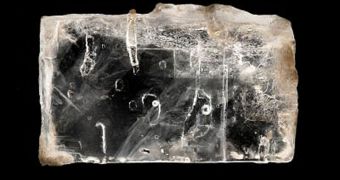A team of experts from the United Kingdom announces that it managed to revive a population of ancient bacteria, that have been trapped inside icy prisons for thousands of years.
The microorganisms have been found inside salt crystals that still contained minute water droplets. They were extracted from sites in Death Valley and Saline Valley in California, Michigan, Kansas and Italy, the group reports.
The idea of extracting microbes and other organisms from such droplets, called fluid inclusions, has been around for years, but until now experts did not know how to go about isolating them.
Some fluid inclusions discovered over the years in various samples have been estimated to range in age from thousands to millions of years. Reviving them could provide hands-on capabilities of studying how the Earth looked like at that time.
In turn, this could lead to a better understanding of how life appeared and developed on our planet, scientists believe. Bacteria and microbes are the most adaptable organisms on Earth, the experts say.
According to Binghamton University professor of geological sciences and environmental studies Tim Lowenstein, the issue that preoccupied experts was whether organisms grew from fluid inclusions would be of the ancient variety, or would be contaminated by various modern materials.
Using a $400,000 grant provided by the US National Science Foundation (NSF), he and professor of anthropology and of biological sciences J. Koji Lum discovered a method of settling these concerns.
In microscope studies, the team was first successful in identifying numerous species of microorganisms, at a much higher degree of biodiversity than they expected.
“Not only did we find bacteria, we found several types of algae as well. The algae actually may be the food on which the bacteria survive for tens of thousands of years,” Lowenstein says.
“You have a little trapped ecosystem. Some of these guys are feeding on other ones trapped in this space. The things that aren't alive in there, their DNA is still preserved,” Lum goes on to say.
He adds that some of the samples contain DNA that goes back over 100,000 years into the past. Because of their diversity, they can inform researchers of the overall environment in which they lived.
“Now we're looking at the DNA from bacteria, the algae, the fungi and what was living in those waters and how those things changed over time,” Lum explains, quoted by SpaceRef.
“We have a view of all the different organisms that were in the lakes at the time these inclusions were formed,” the investigator reveals.
Using DNA sequencing on the recovered bacteria, the team was able to grow the organisms in lab dishes, inside specially conceived culture mediums. Conditions in the distant past were very harsh in terms of salinity and temperature, but they were closely replicated.
“These are some of the hardiest beasts on the planet,” Lum adds. “They're like time capsules,” concludes Lowenstein.

 14 DAY TRIAL //
14 DAY TRIAL //